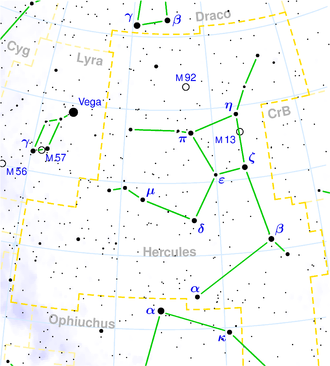NGC 6073
| Galaxy NGC 6073 |
|
|---|---|

|
|
| SDSS recording | |
| AladinLite | |
| Constellation | Hercules |
|
Position equinox : J2000.0 , epoch : J2000.0 |
|
| Right ascension | 16 h 10 m 10.8 s |
| declination | + 16 ° 41 ′ 59 ″ |
| Appearance | |
| Morphological type | Sc: |
| Brightness (visual) | 13.6 mag |
| Brightness (B-band) | 14.3 mag |
| Angular expansion | 1.3 ′ × 0.7 ′ |
| Position angle | 130 ° |
| Surface brightness | 13.3 mag / arcmin² |
| Physical data | |
| Affiliation |
NGC 6052 group LGG 403 |
| Redshift | 0.015494 ± 0.000020 |
| Radial velocity | (4645 ± 6) km / s |
|
Stroke distance v rad / H 0 |
(212 ± 15) · 10 6 ly (65.0 ± 4.5) Mpc |
| history | |
| discovery | Wilhelm Herschel |
| Discovery date | March 21, 1784 |
| Catalog names | |
| NGC 6073 • UGC 10235 • PGC 57353 • CGCG 108-160 • MCG + 03-41-139 • IRAS 16078 + 1649 • 2MASX J16101083 + 1641582 • GC 4167 • H III 74 • h 1948 • SDSS = J161010.84 + 164158.5 • HOLM 731A | |
NGC 6073 is a 13.6 likes bright spiral galaxy of Hubble type Sc in the constellation Hercules at the northern sky . It is estimated to be 212 million light years from the Milky Way and about 80,000 light years in diameter.
The object was discovered on March 21, 1784 by Wilhelm Herschel with an 18.7-inch reflector telescope, who described it as “vF, S, verified with 240 power”.
